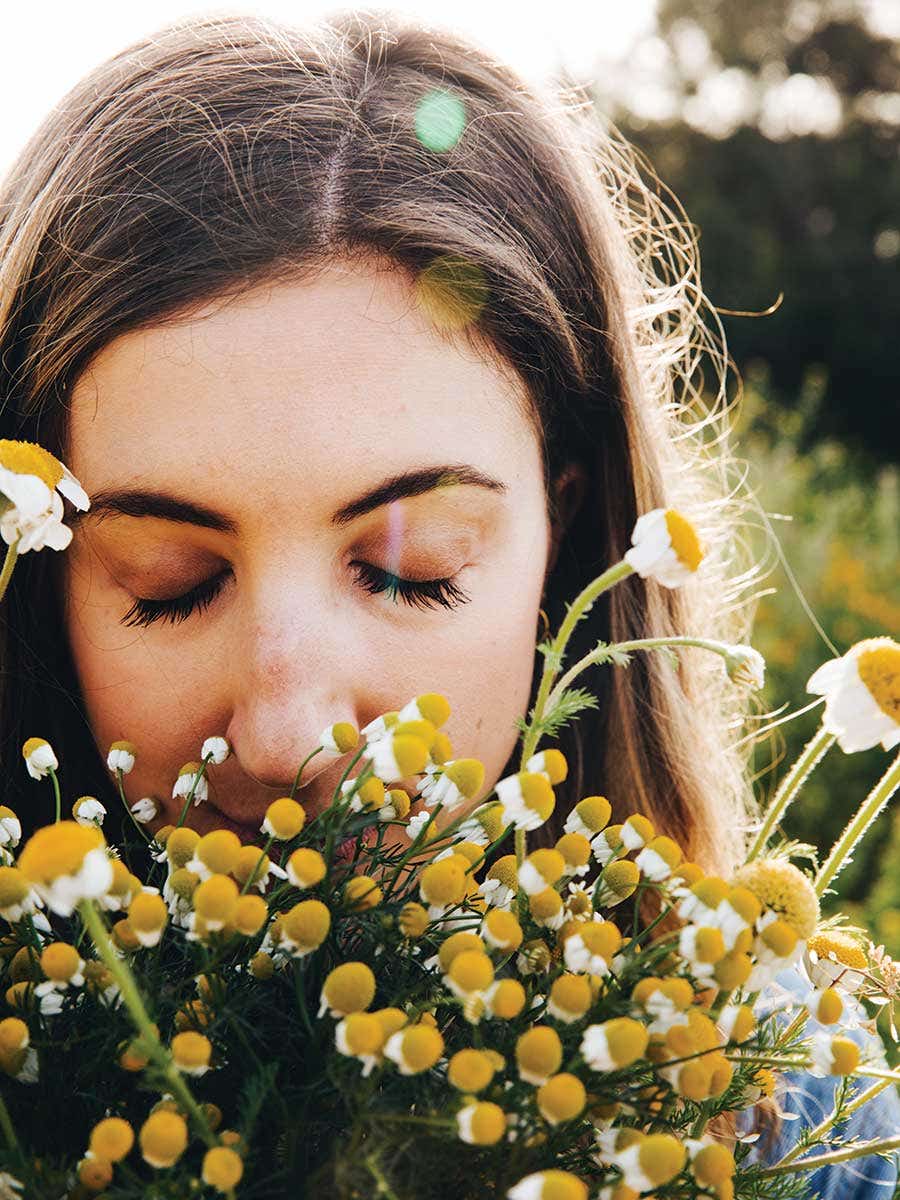
This Garden-Driven Cook is Shaking Things Up In Southern Italy
In a town where tradition drives the food, chef Giorgia Goggi stands out for her creativity
Giorgia Goggi stood wearing rubber boots and holding a blue-handled serrated butter knife. as the 28-year-old cook began shimmying sideways up and down her garden rows like a human harmonica, hacking fattened vegetables off their stems, farm baskets began to fill up: red beets the size of bocce balls; savoy cabbages with leaves fanned out in crinkly orbits; spindly, lime-colored pyramids of broccoli romanesco; bulbous artichokes with deep-purple petals. i was perched on the garden’s wall, trying to save my white sneakers from the red dirt, which looked as if iodine had seeped into it and held there.
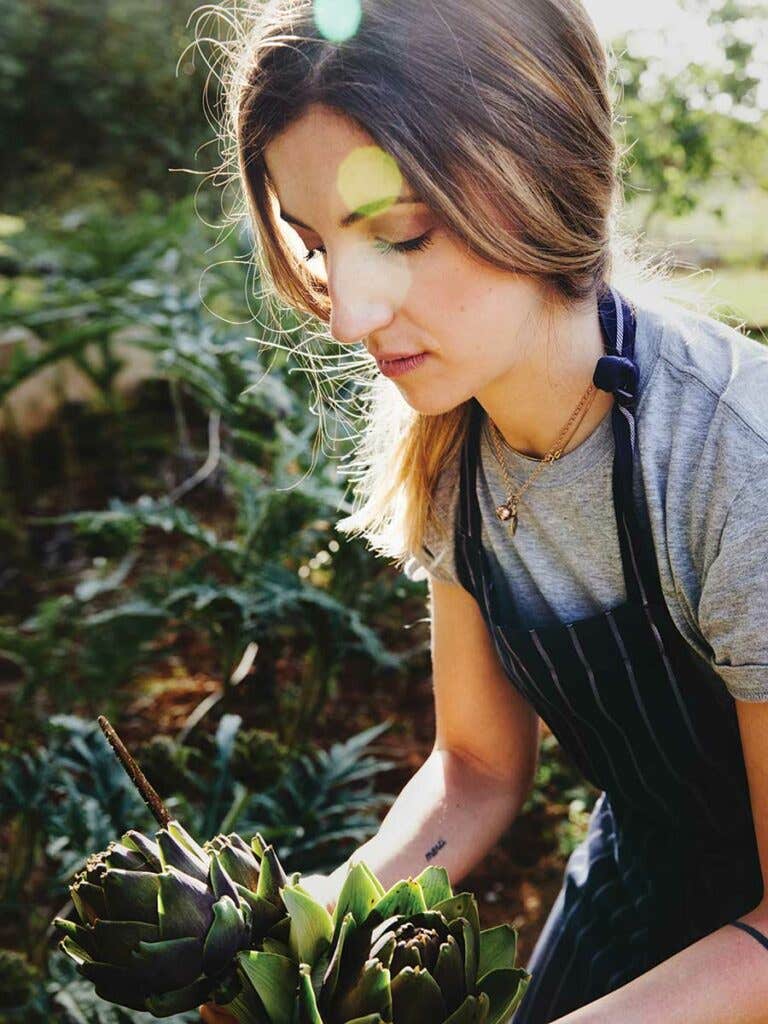
Goggi is the cook at Masseria Moroseta, a whitewashed guesthouse in Ostuni that opened two years ago. A coastal village in Puglia, Ostuni is known by locals and tourists as la città bianca, "the white city," for its blindingly bright buildings and sun-bleached piazzas, and prized by visitors for its nearby beaches. The food here—a devoted but sometimes middling rotation of simple seafood preparations, homespun semolina pastas, legumes, and stuffed or twice-baked breads—is more distinctive for its adherence to tradition than for its creativity. On a winding, splintered road through the countryside is Moroseta, a boxy, chic, contemporary structure plopped in a field of wildflowers, cactuses, and around 600 gnarled, 300-year-old olive trees. The gravitational pull of the vintage-meets-modern style alone has attracted a wait list of international visitors. But I was there for Goggi's dishes, which I'd been trailing from across the pond by word of mouth and a stream of tantalizing photos. In them, where lucid garden colors overlay across each other like an impressionist painting, and cultures and global flavors almost never seen in rural Italy collide, I could see a new Puglia, one I longed to be a part of.
Originally from Milan, Goggi has that Italian city look we American women covet and that betrays her as a transplant to the countryside—thin with a long, once-bleached ponytail, oversize sunglasses, and an elegantly crooked nose. After leaving behind an architectural-design degree to become a cook, she spent five years in Milan working at restaurants cooking everything from Italian to Japanese. As a line cook, Goggi said, she jumped from cleaning prawns for six-hour stints at the sushi station to masterminding pastries for dessert. But since July 2017, when stress and unhappiness got the best of her, Goggi’s been out of the city’s cosmopolitan restaurant circuit and embracing a slower, more intimate cooking experience at the farmhouse—one largely of her own design, and that changes nearly every week as her very first garden grows and evolves.
"There are a lot of masserie around here," Goggi said. It's a word that means farmhouse, but across southern Italy it has also come to signify hotels built in their remains. At Moroseta, the full food experience has been available only to guests staying at the hotel, until this summer, when Goggi and owner Carlo Lanzini introduced limited ticketed dinners. "The way we do food, it's quite unique. It's like a family meal, no menu. I choose every day what we want to cook."
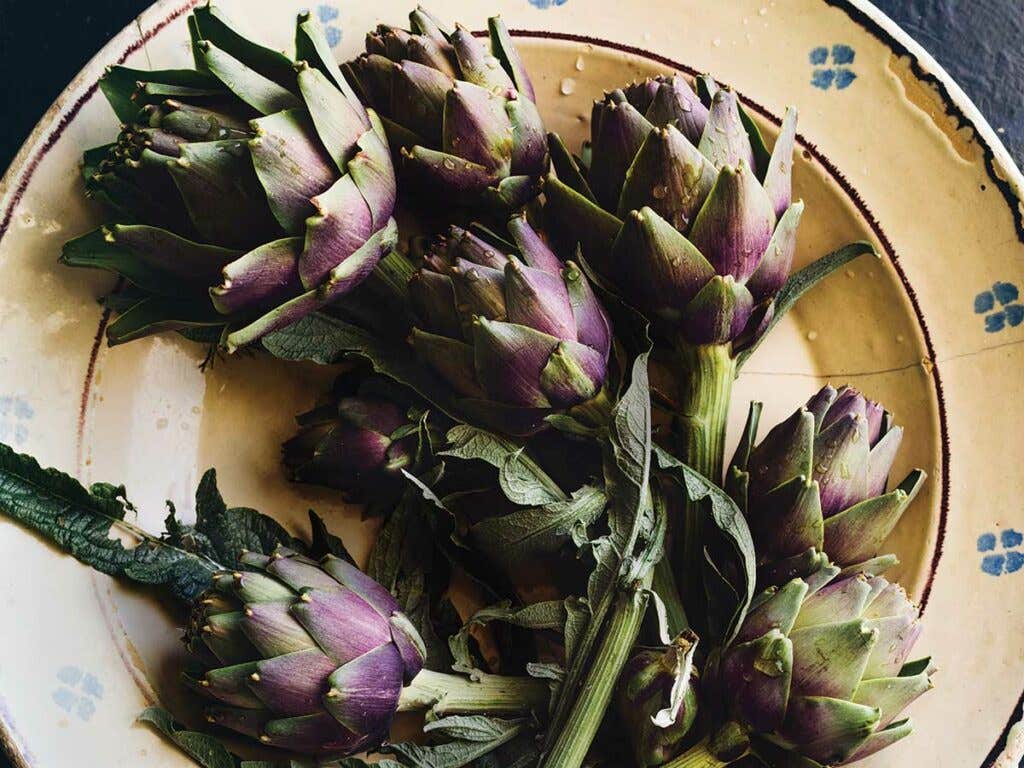
The “we” is mere modesty speaking—Goggi’s been the sole cook at Moroseta mostly since she began the job nearly one year ago. In that short time, she’s transformed a swimming-pool-size portion of the property’s wild backyard into a garden of inspiration for her cooking, complete with a chicken coop. While such a muse might already be commonplace or even cliché in the U.S. food scene, it is groundbreaking in southern Italy, where cooks and many chefs are ritualistic about serving the region’s rustic, traditional dishes.
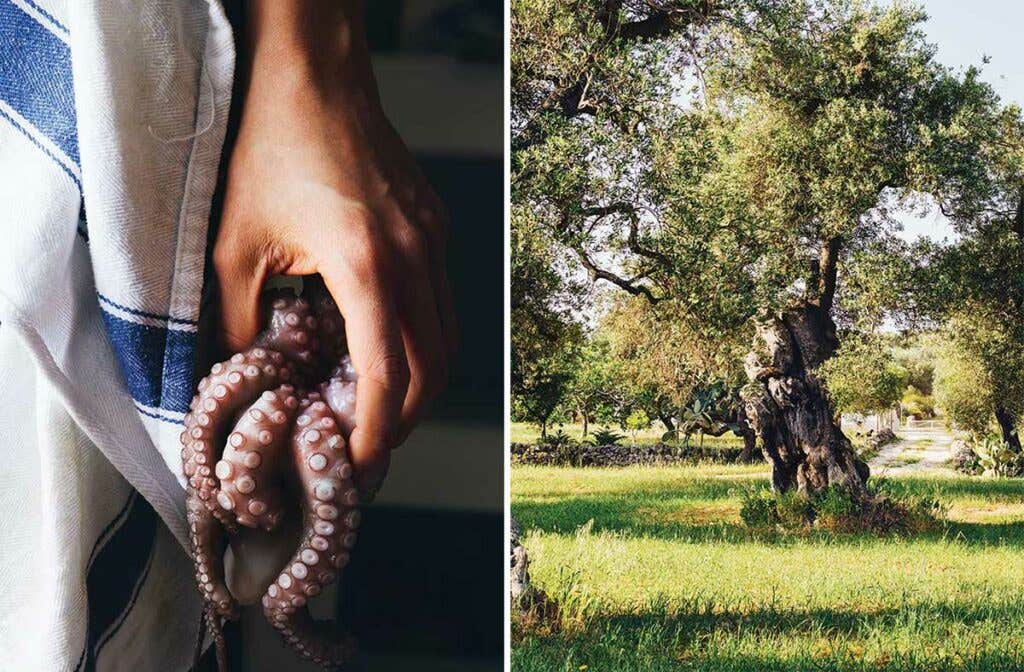
If Italy is a boot shape, Ostuni is, spatially speaking, in its upper heel. Here, summer begins in April, and sinewy bitter greens, not plump tomatoes, are the topping of choice for pasta. Many of the classic recipes are built around what's plucked from the sea: fresh anchovies, mussels baked in bread crumbs or cooked in broth, and smorgasbords of raw seafood "crudo" served on ice, which spans everything from white, crunchy slivers of uncooked calamari to the silky roe of sea urchins. The rest is relatively meager, like rustic handmade maccheroni or purées made with preserved dried beans.
In a place where the hot climate and rich soil dictate that most everything can grow most of the time, however, Goggi is infatuated—obsessed even—with what else is possible. There are tomatoes in April. Figs the size of lightbulbs on trees by early May—these come twice, ripening once in June and again in early September—and lemons with delicate yellow skins, plump pears, and dark red-black ferrovia cherries all sprung up simultaneously while I was there. It’s the abundance that explains why Goggi came to this place for a summer job and never left, and why you kind of can’t blame her for outthinking what’s on typical restaurant menus in the region. For her, Puglia is one of the most obvious and interesting places to cook creatively, but doing so goes against a strain of traditionalism and conservatism that’s long existed in the region.
“Almost anything you can plant thrives here,” Goggi explained. As we strolled the property, dark fruits that looked like blueberries had fallen all over in small piles. Pointing out that they were black olives, she told me the hard work she and Lanzini have put in tending to the old trees—they are now taking in the fruit to be pressed for oil, more than 2,000 liters a year, some of which the staff uses to make soaps and bath products. Alongside the ancient trunks, Goggi has also begun to cultivate finger lime trees, originally from subtropical Australian rainforests, as well as pomelo trees, popular in southeast Asia and China, and found occasionally in the hottest parts of Sicily—her deep respect for the old planted side by side with her lust for the new.
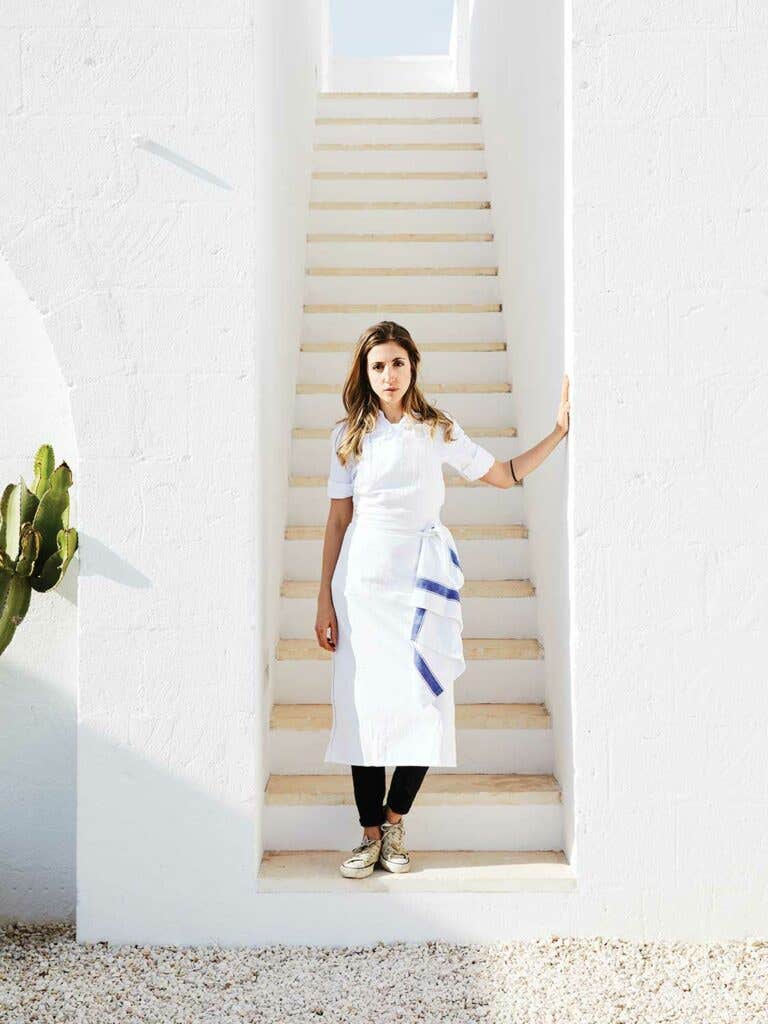
“This is why they think I’m a bit crazy,” she said as we headed toward the house and paused at her bushels of growing herbs. From our talks I knew she was referring to Italian travelers specifically, many of whom have stayed at the masseria and had mixed reactions to her experimental food. This type of reaction is common in the culinary culture as a whole. “The cooks here favor basil, rosemary, and sage in everything,” she said, “and when you work in a restaurant and propose using marjoram instead of basil in a red sauce, you are looked at like you are insane. I’ve been trying to plant as many of the different varieties of herbs and citruses and vegetables that I couldn’t find in Puglia, such as lemon balm, verbena, and coriander. Coriander especially is something I could never find here.” As she reached down to massage the leaves with her fingertips, the plants at her ankles almost appeared to be looking up at her like small, loyal pets.
Inside, we flooded the long skinny farm table with the morning’s pickings. At the stove, Goggi briskly stirred beaten eggs with yolks the color of blood oranges in a pan. “For breakfast, if Italians don’t find normal grandma cookies or plain cake, it’s quite shocking for them. If you propose eggs—or any juice besides orange juice or maybe strawberry—they look at you like you are crazy.” That morning, we’d had iced fresh ginger root, garden-grown mint, and green tea, served mixed together with Pugliese honey in a chilled wineglass. Preserved orange marmalade, homemade strawberry jam, and pillowy focaccia were served alongside strands of pulled burrata with soft little morsels of sautéed zucchini and asparagus.
“What we do every day in the kitchen depends on what we find out in the garden,” she said, her sincerity reminding me that this is still an oddly big deal in Puglia. Her gorgeous, vegetable-driven, updated Italian food—and Lanzini’s taste in decor—has been enough of an attraction for young, stylish guests from all over to excuse Moroseta’s remote location. During my stay, the guests filling the rooms were from China, Berlin, Montreal, and Australia. I was there from New York, which might be why I found her style—clearly rooted in Italian tradition but infused with subtle influences from Asia, India, and America, to name a few—not only normal but ideal.
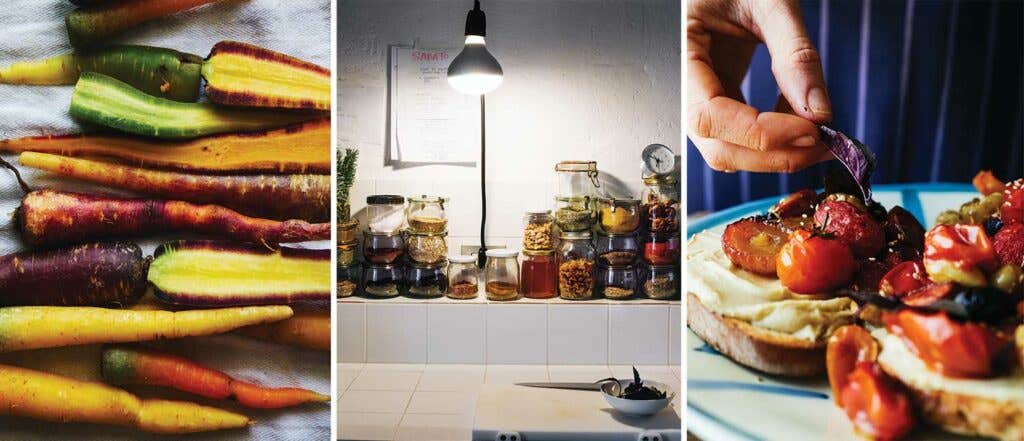
“Most Italians who visit from other parts of Italy are not open-minded about the way we cook,” Goggi said outright. “It’s quite rare that they appreciate what we do with the food.” “I’m blending bread crumbs. It’s going to be quite loud,” Goggi warned from a corner of the kitchen, where beneath her rolled-up gray T-shirt sleeves I could see a tattoo on the back of each of her skinny elbows. “I try not to waste leftover bread. I toast it, dry it out, and then use it for bread crumbs or panzanella.” The bread was so hard and stale it shrieked through the food processor with a nails-on-a-chalkboard scream. On the other side of the room, a metal pot percolating on the stove let off a sweet, herbal, and apothecary-esque fragrance that cloaked everything: celery leaves, deep-red cherry tomatoes with their skins split open from cooking, wedges of purple onion, and four or five fresh lemon leaves from the property’s trees, which looked like enlarged bay leaves.
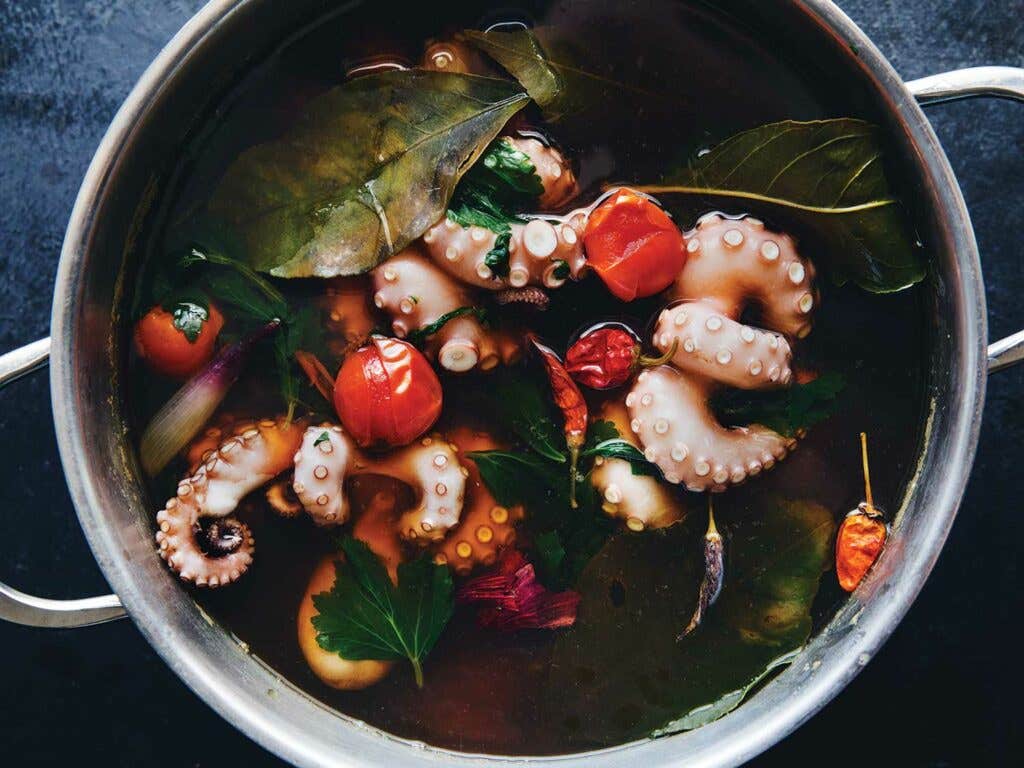
“This is for stewing the octopus to make a sugo,” a concentrated, slow-cooked pasta sauce, Goggi told me as she filled the pot to ready dinner. She removed from the refrigerator three tiny octopuses, each the perfect size to straddle the palm of your hand with their tentacles. Within seconds of lowering them into the braising liquid, their limbs tightened and ends coiled, and their whitish gray outsides began to take on a purple hue.
All around the room, jars of all sizes—husky, squat, curvy, and thin—leaned along the kitchen’s ledges like patrons at a bar. Goggi sprinkled a few whole dried Calabrian chiles into the octopus pot from a jar with a red lid. Next to it was one marked “liquirizia” (licorice)—a fine, espresso-like powder; another contained oily, shriveled taggiasca olives; and another a seed mix of buckwheat, sunflower, and pepitas. Inside some are spices and blends I don’t see in most kitchens and I’ve never seen in any kitchen in rural Italy: Middle Eastern za’atar, Egyptian dukkah, and Indian masala spice among them.
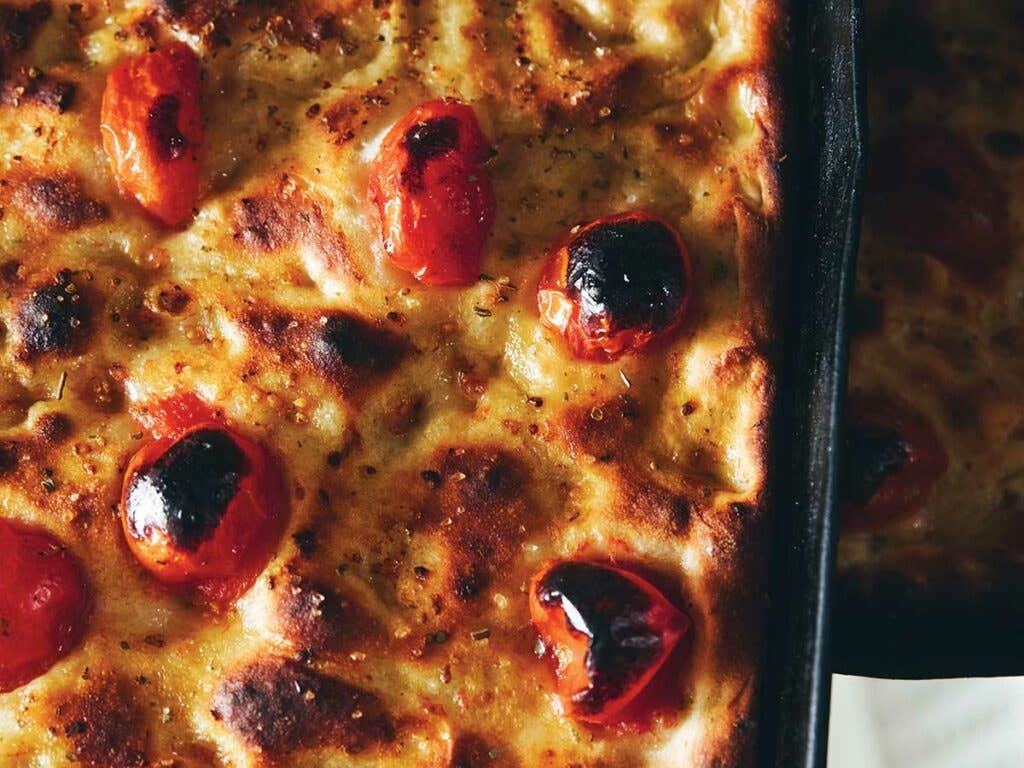
“I like to make blends and spices of my own,” she said. “Here are dried rose petals I mixed with crushed pink peppercorns.” She palmed the lid of one jar and peeled it open, revealing a musty-smelling purple-flecked salt inside. “I flavored sea salt with lavender. It works very well on top of a simple tomato salad.” There were bottles of Squid-brand Thai fish sauce, sake, and bottles of vinegar from rice to white wine nearby.
One container held what appear to be blackened, dried Brazil nuts, but Goggi corrected me. “Tonka beans,” she said proudly. “They smell like licorice and vanilla and the scent of an orchid flower. You grate them with a microplane, and the flavor is very sweet. But I come from Milan, which is the land of risotto, so I like it with a strong blue cheese risotto.”
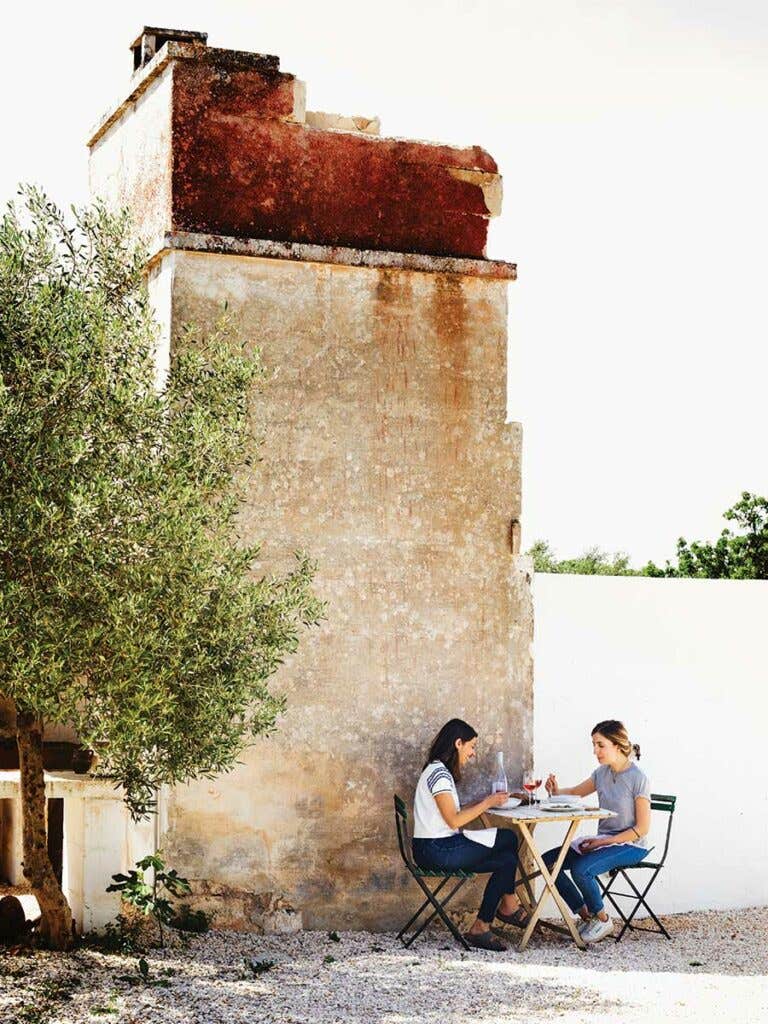
Throughout the few days of my stay, these jars proved as important as her garden experiments in giving her food its outside-the-box flavors in Italy. “I am obsessed with timut peppercorn,” she said, tipping another jar toward me. To my nose, it was almost identical to marijuana. “I find it very citrusy,” Goggi said, whiffing it to confirm. “I like to pair it with chocolate or with strong meat like pigeon, beef, lamb. I like meat that tastes like meat.” Nigella seeds, of which she has a full jar, “taste a lot like oregano to me, but also give a crunchiness. Not many people use them around here, but they do have a Mediterranean taste.”
For a cook as globally minded as she is, Goggi never complains about classic Pugliese—or any Italian—food. "All I remember from my childhood is linked to food. My mom makes very traditional dishes, like the best brodo with tortellini. It's something I really crave all the time. The only change is that now when I go home, she says to me, 'You do the vegetables.'"
Like many chefs, especially these days, Goggi describes herself as an acid junkie, a cook of contrasts and racy brightness. “Citrus and vinegar are things I can’t avoid using. It’s like the punctuation of the dish.” It’s true that lemon and acid featured prominently in everything we ate: Crispy bread crumbs for topping pasta got a generous pinch of grated lemon zest and fennel seed. Miso-roasted yellow tomatoes were sprinkled abundantly with sour, tart ground sumac. And as an antipasti, she served paper-thin strips of zucchini and red onion wilted in straight vinegar with mint leaves, a floral-tasting, neon-pink-and-green treat I instantly loved. But more than anything, I found her dishes to have a unique sweetness in both flavor and personality. A pear-topped spelt cake smelled of muscovado and the honey glaze it was brushed with after baking. The pasta with octopus sugo—the meal for which her lemon-leaf braise was destined—had the nectary aroma of saffron and long-cooked tomatoes. Fig leaves from the property, which Goggi says have a coconutlike flavor, were used to infuse oil with sweetness for salsa verde. And marinated anchovy fillets were topped with soaked white raisins and syrupy arcs of candied orange peel.
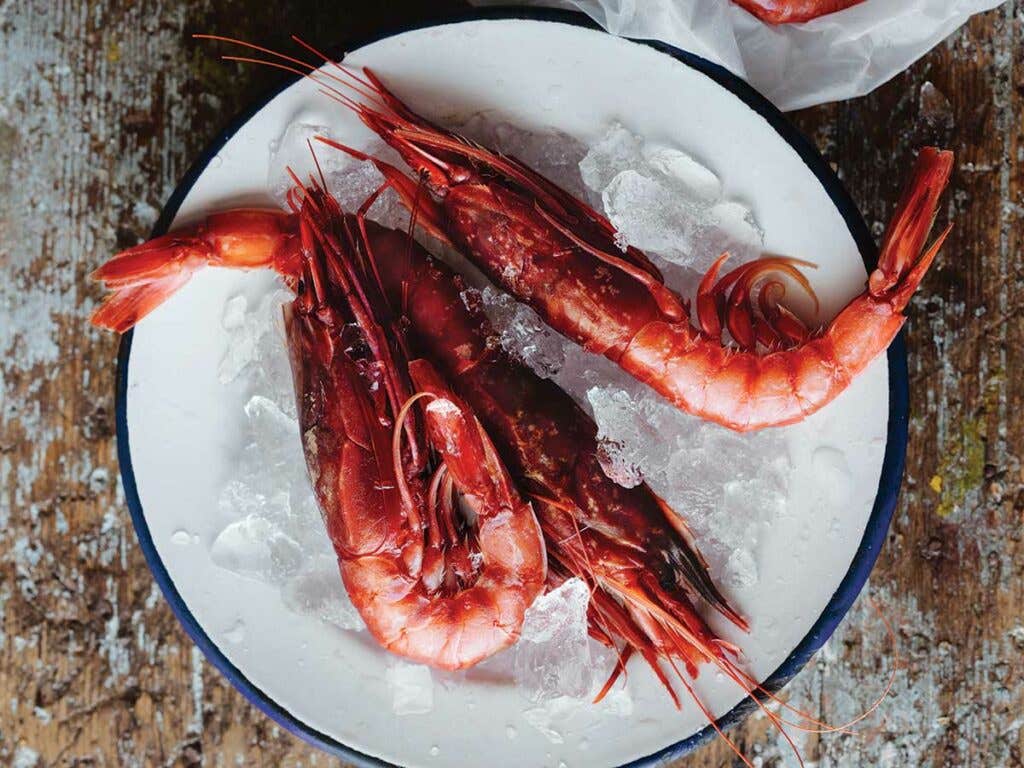
“This dish is totally my mother,” she said of the anchovy dish, the white plate and the silvery skins of the fish eye-piercingly bright in the midday Pugliese sun. “She would make it with different kinds of marinated fish, but the candied citrus peel, the onions, and the dried fruit are all hers.” We scooped up the tiny fillets with pickled red onion and plump olives alongside crisp local rosé made from primitivo del Salento, a local grape produced between the region’s two coasts. It was a dish and a day that could burn your eyes without sunglasses, which left me delirious upon reentering the kitchen.
“The only thing is, it’s not as easy to get ingredients here as it is in a big city,” Goggi said, “but there are some little specific shops that are helping me. There is this super-tiny organic shop nearby that has, like, three things, but every time I go there and ask for something new, such as miso, they try to find what I want and bring it here.” She’s had a similar experience with the local cheesemakers who, since seeing her patronize their businesses regularly, have warmed up to helping her. “I couldn’t find any crème fraîche or buttermilk here, but I proposed it to a cheesemaker. Now we are making some trials together, and I’m super happy about it.” Some, like the cheesemakers, have begun to call her “Gio” (said like “Joe”), which she blushed at upon sharing. “The thing with people in Puglia is that if they love you somehow, they try to help you and please you in any way possible.”

On the last morning, when the bellowing rummmm-rumm of the tractor began and I was awake with no chance of returning to sleep, we seized our 5 a.m. wake-up to visit a traditional masseria, an actual family-owned farmhouse that produces traditional products for sale in a small, barely marked shop in the countryside. Inside Goggi’s car, the navigation spewed a sinistras (lefts) and a destras (rights) from between us. We passed through Martina Franca, the largest town in the area, which is postcard Puglia—all white facades, ironwork balconies, and magenta flowers. When we arrived at the bakers’ kitchen, not typically open to the public, rows of hundreds of friselle—brittle, twice-baked biscuits used to sop up pasta sauces and the region’s vegetable stews—were laid out on towels to proof. An older man plunged his fingertips into focaccia dough spread out in dark, warped pans, then squeezed fresh tomatoes to release their juices over the top. Birds chirped feverishly outside the door. In another corner, a younger man portioned out bags of flour. Little crates of loaves lay proofing between scrunched white linens. “There are different brothers who run things here,” Goggi said. “Some bake bread. Some make vegetables. Some take care of the dairy. There are sisters too, but they do the selling.” The older man threw piles of olive-tree trimmings into the wood-fired oven and began to load in the trays.
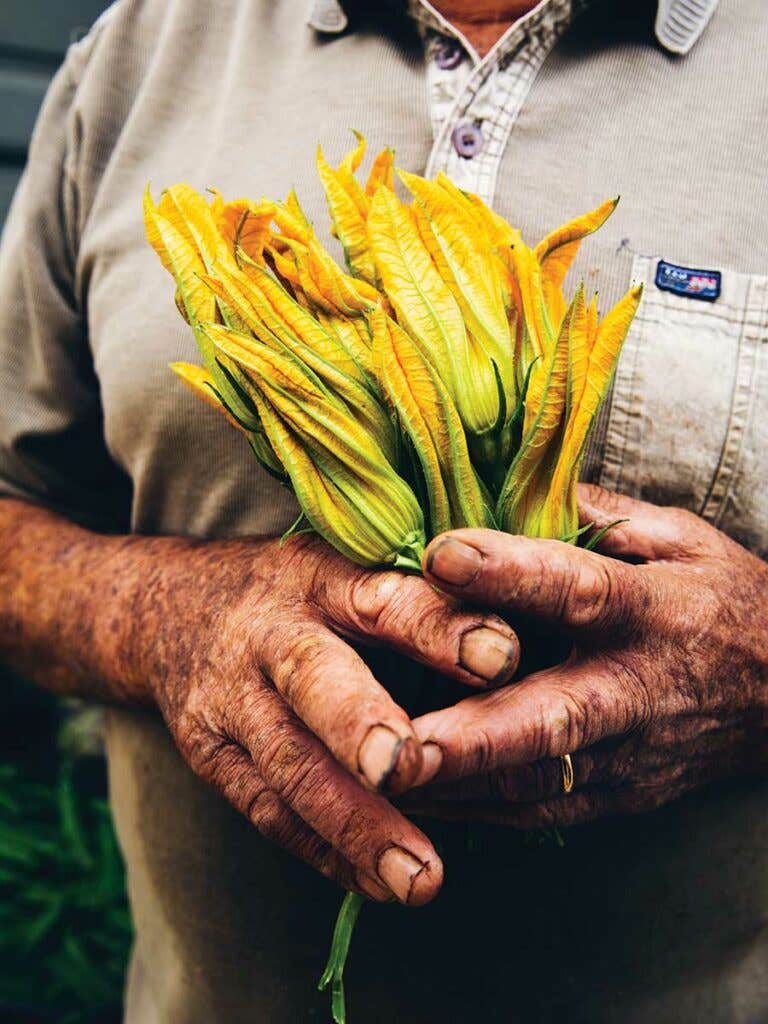
When the focaccia was done, he trimmed off hulking rectangles for us to eat. The tomato juices had caramelized into smoky blackened patches on the top of the dough, and everything shone with olive oil. We walked around the property while we ate. A guy in a jumpsuit smoked a cigarette while milking a cow.
Outside, a man named Giuseppe, one of the elder brothers, showed us where patches of wild chamomile and elderflower had grown in leggy heaps. Goggi pressed her hands together at her chest with excitement and scurried off, leaving me to finish my bread among the smells of the farm. She returned with a massive bundle of each flower, white and yellow and with tiny garden bugs still crawling through their stems. We used the chamomile to make gelato that night, which Goggi scooped onto slices of her golden pear cake. In Italian, speaking straight to Goggi, Giuseppe asked where I'm from, not knowing I understood the language. "Stati uniti," she said back. The U.S.
“Ah,” the man said, with the slightest hint of an eye roll. “So she’s here in Puglia just to eat.”
“Sì,” Goggi nodded and smiled. “Me too.”
The New Cooking of Puglia
Pasta with Octopus Ragu and Stracciatella
Giorgia Goggi mixes this slow-cooked tomato sauce with octopus and saffron into paccheri pasta di Gragnano, a thick, air-dried Italian macaroni. But any robust pasta shape will do. Get the recipe for Pasta with Octopus Ragu and Stracciatella »
Yellow Tomato Soup with Lamb Meatballs, Yogurt, and Mint
“Spices have always fascinated me. I collect them from all over the world,” says Giorgia Goggi, who accents this soup with Middle Eastern sumac and Indian garam masala. If you can’t find fresh yellow tomatoes, red will work just as well. Yellow Tomato Soup with Lamb Meatballs, Yogurt, and Mint »
Roasted Tomato and Grape Toasts with Fava Bean Puree
Dried fava bean purée is served all over Puglia, typically with cooked bitter greens and fried or toasted bread. Giorgia Goggi adds lemon juice and miso, and uses it as a base for crostini. Leftovers are an excellent dip for raw vegetables. Get the recipe for Roasted Tomato and Grape Toasts with Fava Bean Puree »
The dark-purple, orange, and yellow carrots of Polignano—a town north of Ostuni on Italy’s Adriatic coast—have a startlingly bright color and punchy flavor. But any colorful, tender carrot will do. Goggi tops this salad with a tart, preserved-lemon vinaigrette, some cumin, mounds of burrata, and pomegranate seeds. “Pomegranates grow wild all over Italy, but Italians typically don’t use them,” she says. Get the recipe for Radicchio and Polignano Carrot Salad with Burrata and Pomegranate »
Ginger and Cocoa Nib Cannoli
Two days resting in the fridge helps cannoli dough become light and bubbly. You will need cannoli molds for frying. Serve within a few hours, before the shells soften. Get the recipe for Ginger and Cocoa Nib Cannoli »
Chamomile Gelato
“I try to draw attention to the great ingredients we have in Puglia,” says Goggi, who infuses gelato bases with fig leaves, lemon balm, and, in this case, fresh chamomile flowers (pictured above). Carob powder, made from the pods of a tree of the same name, adds a light, cocoa-like flavor and color. If it’s difficult to find, use cocoa powder. Get the recipe for Chamomile Gelato »
Keep Reading
Continue to Next Story










